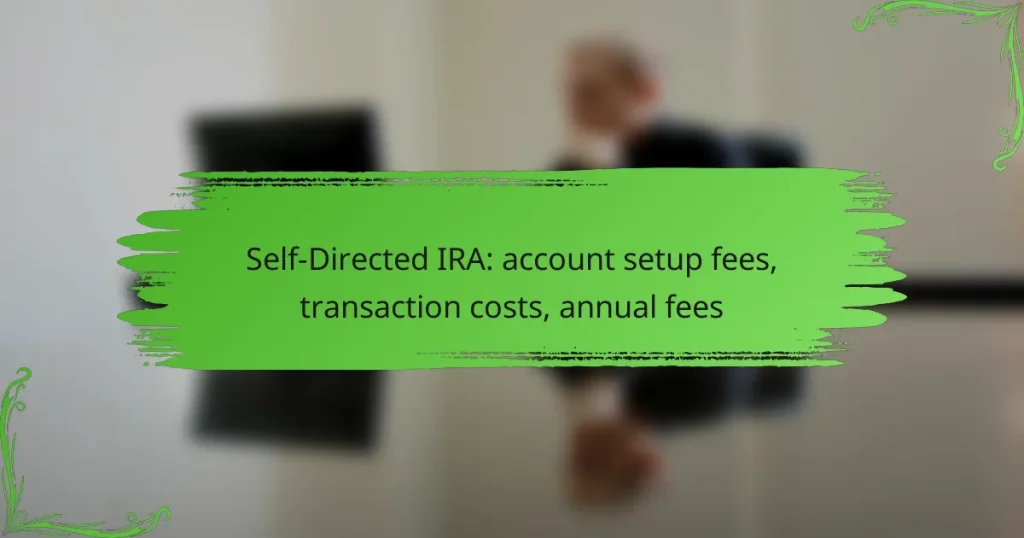Setting up a Self-Directed IRA involves various fees that can impact your investment strategy. Account setup fees typically range from £50 to £300, while transaction costs depend on the type of investments and custodian involved. Additionally, annual fees vary by provider and cover essential services such as account maintenance and compliance reporting.
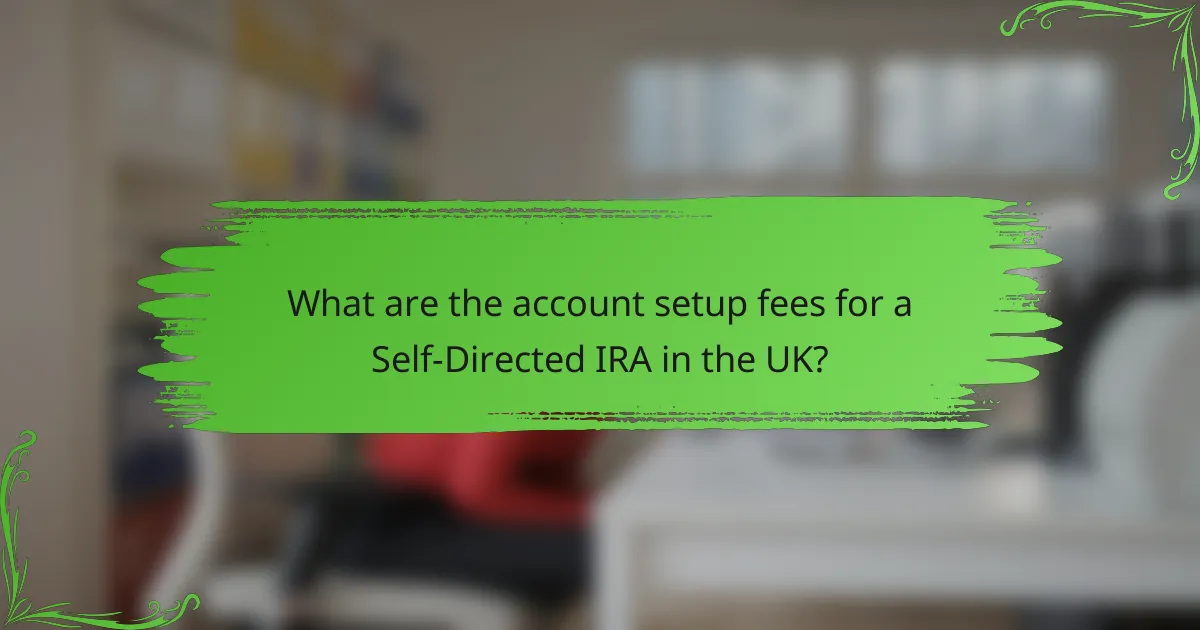
What are the account setup fees for a Self-Directed IRA in the UK?
Account setup fees for a Self-Directed IRA in the UK typically range from £50 to £300, depending on the provider and the complexity of the account. These fees cover the administrative costs associated with establishing the account and ensuring compliance with regulations.
Typical setup fees range from £50 to £300
When setting up a Self-Directed IRA, you can expect to pay between £50 and £300 in initial fees. This range reflects the basic administrative costs and may vary based on the services included, such as account management and investment options. It’s essential to compare these fees among different providers to find the best fit for your investment strategy.
Some providers may offer promotional rates or waive setup fees if you meet certain investment thresholds. Always read the fine print to understand what services are included in the fee structure.
Fees vary by provider, e.g., Equity Trust vs. The Entrust Group
Different providers have distinct fee structures for Self-Directed IRAs. For instance, Equity Trust may charge a flat fee for account setup, while The Entrust Group might have a tiered pricing model based on the account balance or the number of transactions. Understanding these differences can help you make an informed decision.
Additionally, consider the ongoing fees associated with each provider, such as annual maintenance fees or transaction costs, as these can significantly impact your overall investment returns. Always request a complete fee schedule before committing to a provider.
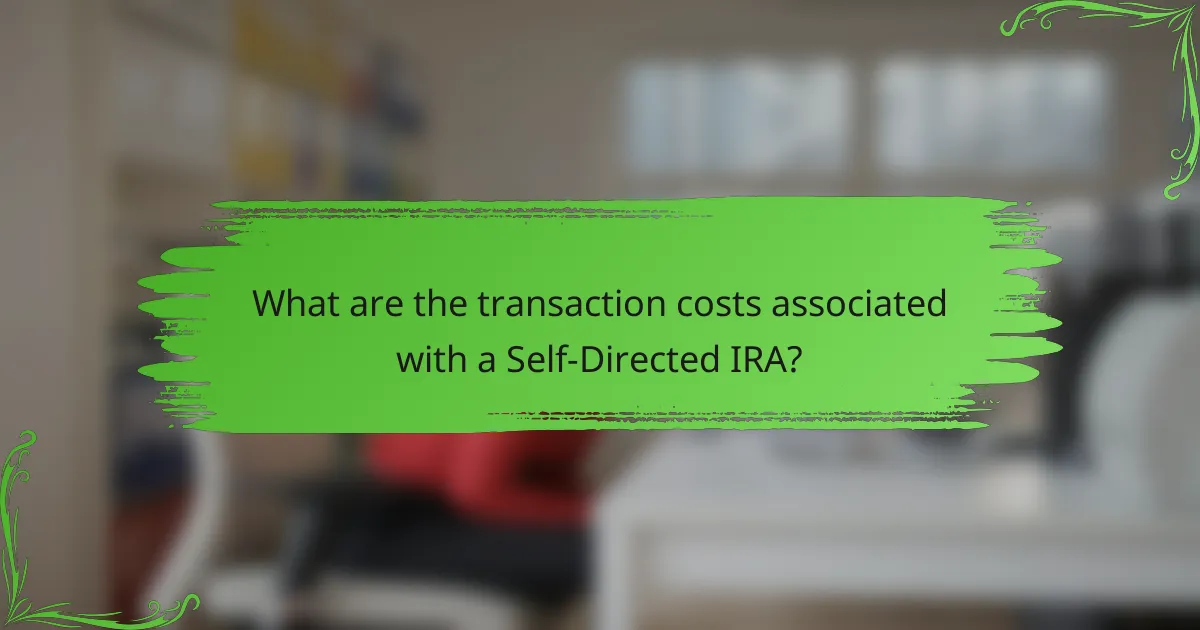
What are the transaction costs associated with a Self-Directed IRA?
Transaction costs for a Self-Directed IRA can vary significantly based on the type of investment and the custodian managing the account. Generally, these costs are incurred each time you buy or sell an asset within the IRA.
Transaction costs can range from £5 to £50 per trade
Most custodians charge transaction fees that typically fall between £5 and £50 for each trade executed within a Self-Directed IRA. These fees can depend on the complexity of the transaction and the custodian’s pricing structure. It’s essential to review the fee schedule of your chosen custodian before making trades.
For example, a simple stock trade might incur a lower fee, while more complex transactions, such as purchasing real estate, could attract higher costs. Understanding these fees can help you plan your investment strategy more effectively.
Costs depend on asset type, e.g., real estate vs. stocks
The type of asset you are trading in your Self-Directed IRA significantly influences the transaction costs. For instance, buying and selling stocks usually incurs lower fees compared to real estate transactions, which may involve additional costs like appraisal fees and closing costs.
When investing in alternative assets, such as real estate or private equity, be prepared for higher transaction costs. It’s advisable to calculate these potential costs in advance to ensure they align with your overall investment goals and budget.

What are the annual fees for maintaining a Self-Directed IRA?
Annual fees for a Self-Directed IRA can vary significantly based on the provider and the services offered. Typically, these fees cover account maintenance, reporting, and other administrative tasks necessary to keep the account compliant and operational.
Annual fees typically range from £100 to £500
Most Self-Directed IRA providers charge annual fees that generally fall between £100 and £500. The exact amount often depends on the complexity of the account and the range of services provided. For instance, accounts with more diverse investments or additional services may incur higher fees.
When selecting a provider, consider not only the annual fee but also the services included. Some providers may offer lower fees but charge extra for essential services, which can add up over time.
Fees may include account maintenance and reporting
Annual fees for a Self-Directed IRA often encompass account maintenance and reporting costs. Account maintenance fees cover the administrative work needed to manage the account, ensuring compliance with IRS regulations.
Reporting fees may apply if the provider offers detailed statements or tax reporting services. It’s crucial to clarify with your chosen provider what specific services are included in the annual fee to avoid unexpected costs.
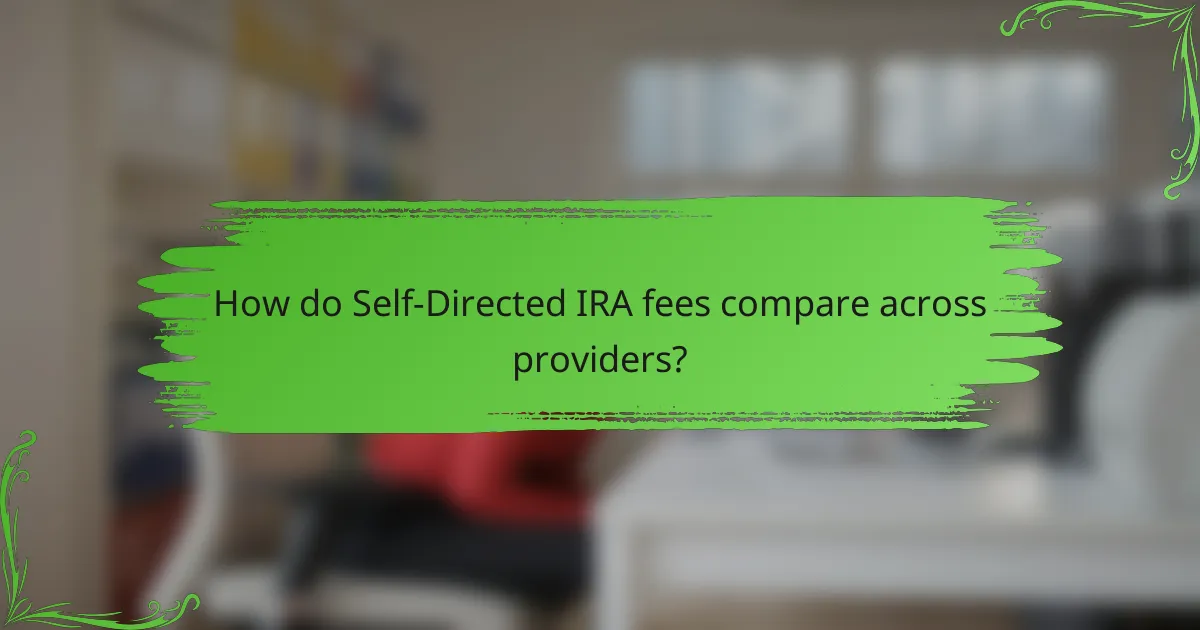
How do Self-Directed IRA fees compare across providers?
Self-Directed IRA fees can vary significantly among providers, impacting your overall investment returns. Key fee categories include account setup fees, transaction costs, and annual maintenance fees, which can influence your choice of provider.
Comparison of fees between Fidelity, Charles Schwab, and Vanguard
Fidelity typically offers low-cost options with no account setup fees and minimal annual fees, making it attractive for investors looking to minimize costs. Charles Schwab also has competitive pricing, often charging low transaction fees but may have higher annual fees depending on the account type. Vanguard is known for its low expense ratios, but it may impose higher fees for certain transactions.
For example, Fidelity may charge around $0 for account maintenance, while Schwab could range from $0 to $50 annually. Vanguard’s fees can vary widely based on investment choices, with some funds having higher expense ratios.
Factors influencing fee structures among different providers
Several factors influence the fee structures of Self-Directed IRAs, including the type of investments offered, the level of customer service, and the technology platforms used. Providers that offer a wider range of investment options, such as real estate or commodities, may charge higher fees to cover the additional administrative costs.
Additionally, the quality of customer support can impact fees; providers with extensive resources for client assistance might charge more. It’s essential to evaluate what services are included in the fees and whether they align with your investment strategy.

What prerequisites should I consider before opening a Self-Directed IRA?
Before opening a Self-Directed IRA, consider your eligibility, the necessary documentation, and initial funding requirements. Understanding these prerequisites will help ensure a smooth setup process and compliance with regulations.
Eligibility requirements for account holders
To open a Self-Directed IRA, you must be an individual who meets the IRS eligibility criteria, which generally includes being at least 18 years old and having earned income. Additionally, certain individuals, such as those with existing retirement accounts or those who are not disqualified persons, are typically eligible.
Disqualified persons include your spouse, ancestors, lineal descendants, and certain fiduciaries. It’s crucial to ensure you do not engage in prohibited transactions, as this could jeopardize your tax-advantaged status.
Necessary documentation and initial funding
When setting up a Self-Directed IRA, you will need to provide specific documentation, including a completed application form, identification, and possibly a transfer request if rolling over funds from another retirement account. Ensure all documents are accurate and up-to-date to avoid delays.
Initial funding can vary based on the type of assets you plan to invest in. Many custodians require a minimum initial deposit, often ranging from a few hundred to several thousand dollars. Be prepared to fund your account sufficiently to cover both investments and any associated fees.
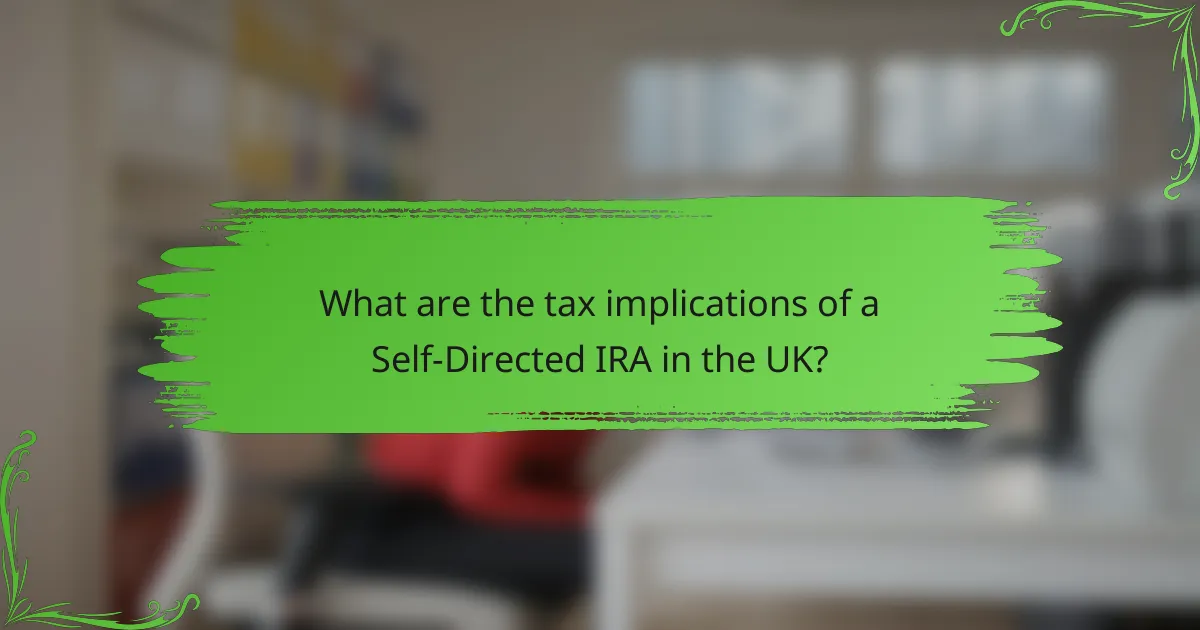
What are the tax implications of a Self-Directed IRA in the UK?
A Self-Directed IRA in the UK offers specific tax advantages, but it also comes with potential tax liabilities that account holders should understand. These accounts allow for a broader range of investments, which can impact tax obligations both during the accumulation phase and upon withdrawal.
Tax advantages of using a Self-Directed IRA
One of the primary tax benefits of a Self-Directed IRA is the ability to grow investments tax-deferred. This means that any income generated within the account, such as dividends or capital gains, is not taxed until funds are withdrawn. Additionally, contributions to a Self-Directed IRA may be tax-deductible, depending on individual circumstances and income levels.
Another advantage is the flexibility in investment choices, which can include real estate, commodities, and private equity. This diversification can lead to potentially higher returns, which, when compounded over time, can significantly enhance the overall growth of the retirement portfolio.
Potential tax liabilities on withdrawals
Withdrawals from a Self-Directed IRA are subject to income tax, and the rate will depend on the individual’s tax bracket at the time of withdrawal. If funds are taken out before the age of 55, additional penalties may apply, typically around 25% of the amount withdrawn. This makes it crucial to plan withdrawals strategically to minimize tax liabilities.
Moreover, if the account holder fails to adhere to the required minimum distribution (RMD) rules after reaching retirement age, they could face substantial penalties. It’s advisable to consult with a tax professional to ensure compliance and to optimize tax outcomes when withdrawing funds from a Self-Directed IRA.

What emerging trends are shaping Self-Directed IRAs?
Self-Directed IRAs are increasingly influenced by trends such as the rise of alternative investments, regulatory changes, and technology advancements. Investors are seeking more control over their retirement funds, leading to a growing interest in diverse asset classes beyond traditional stocks and bonds.
Account Setup Fees
Account setup fees for Self-Directed IRAs typically range from $50 to $500, depending on the custodian and the complexity of the account. Some custodians may waive these fees for accounts with higher initial contributions or offer promotional rates.
When selecting a custodian, consider not only the setup fee but also the services included. Some custodians provide additional resources, such as educational materials or investment guidance, which can justify higher fees.
Transaction Costs
Transaction costs for Self-Directed IRAs can vary significantly, often falling between $5 and $50 per transaction. These fees apply to buying or selling assets within the account, and they can accumulate quickly if you frequently trade.
It’s essential to review the fee structure of potential custodians. Some may offer flat-rate plans or unlimited transactions for a monthly fee, which could be more economical for active investors.
Annual Fees
Annual fees for maintaining a Self-Directed IRA generally range from $100 to $300. These fees cover account administration, reporting, and compliance services provided by the custodian.
Be aware that some custodians charge additional fees for specific services, such as asset valuation or tax reporting. Always ask for a complete fee schedule to avoid unexpected costs throughout the year.
